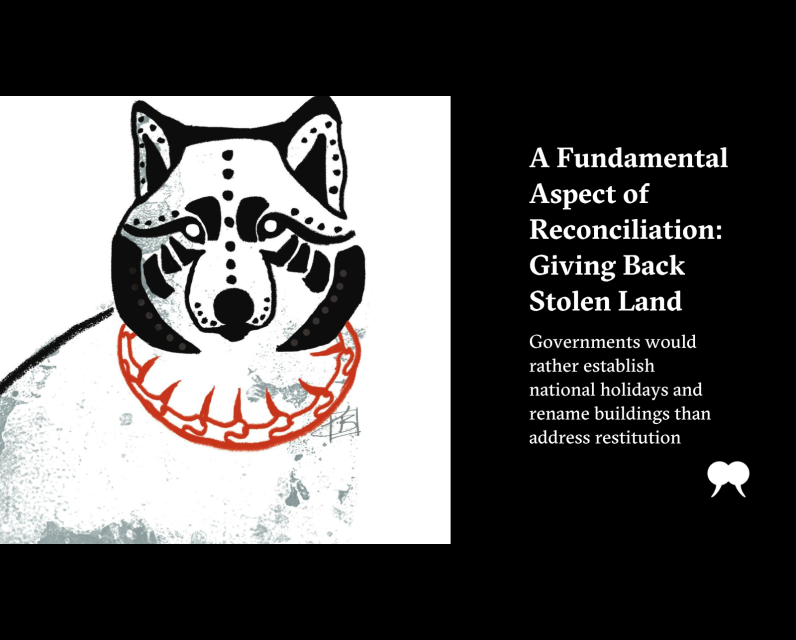A Fundamental Aspect of Reconciliation: Giving Back Stolen Land

In 2024, the Haida Nation reached an agreement with the provincial government of British Columbia and the federal government to return the nation’s authority and jurisdiction over its ancestral archipelago, Haida Gwaii. This historic agreement was the first title case to be settled through negotiation with the federal government rather than through courts. According to the Canadian government, there are more than 170 such rights-based negotiations currently in process.
In the same year that the Haida title was achieved, Ottawa also transferred jurisdiction and authority over Crown lands and subsurface rights in Nunavut to the territorial government. While not an exclusively Indigenous government, the Government of Nunavut typically features strong elected Inuit representation, along with additional structures in place to ensure that Inuit voices are heard in the political process. Many saw these two milestones as examples of long overdue land and resource restitution—key tenets of the Truth and Reconciliation Commission’s report—in action.
-
Read more from our Truth and Reconciliation series:
- Intro
- Truth
- Child Welfare
- Economic Development
- Gender
- Media
But these milestones are the exception, not the norm. In the decade since the TRC released its Final Report, Canada has largely failed to address fundamental issues, such as stolen land and resources, preferring to pursue actions that do not existentially threaten settler-colonial interests (establishing national holidays, renaming buildings and places, and conducting inquiries whose calls to action have been generally ignored, for example).
It’s in this context of relative inaction that “Land Back”—the slogan, the movement—emerged in the late 2010s and early 2020s, thanks in no small part to Indigenous youth online. Land Back calls on colonial countries such as Canada to prioritize the return of lands and other material goods in its quest for transformed relations, as well as to empower Indigenous people to continue the generations-long fight to reclaim what is rightfully theirs, regardless of support from the state.
In 2020, members of Six Nations of the Grand River staged a standoff against developers seeking to build residential properties on twenty-five acres of land claimed by the First Nations, dubbing it 1492 Land Back Lane. Today, we see First Nations in the far north of Ontario promising blockades if the provincial and federal governments attempt to extract resources from their traditional homelands without their consent. As of late June, encampments have already begun to take root.
Such examples of grassroots Land Back movements threaten to become increasingly frequent, particularly as many Indigenous people seem skeptical about whether the newly elected Mark Carney government will prioritize resolving conflicts related to Indigenous title, as thus far in his term, he appears to prefer talking about economic reconciliation via resource extraction projects rather than land restitution. It’s a far cry from Justin Trudeau’s cabinet, which took up the language of Land Back explicitly, indicating Indigenous title as a priority issue even if their progress on the issue was flawed.
But Carney’s change in tone highlights a broader problem than any current lack of progress on Land Back: Canadian governments continually treat Indigenous title as a “policy issue” rather than a legal obligation and fundamental right. Why are Indigenous people always made to fear that these rights are threatened by the changing whims of Canada’s government of the day?
The Nunavut and Haida cases show the benefits of the Canadian state becoming actively involved in Indigenous title cases: Indigenous nations can avoid decades of costly and exhausting court battles, and they can also achieve significant land returns in a single transaction, rather than fight for the land one acre at a time. But these negotiations require a willing partner, and Canada’s willingness depends on its own interests and priorities.
Still, even with the potentially preferred partners in the Trudeau government, would Canada have been so eager to strike a deal to recognize Haida title if they wanted to build a pipeline on that land, or would they use militarized force, as they have in the Wet’suwet’en Yintah? Would they strike such agreements with treaty nations whose territories encompass major metropolitan centres, such as Montreal and Calgary?
Even at its most reconciliatory, Canada engages in Land Back initiatives selectively: only in instances where the political and economic stakes remain relatively low and it can purchase some public and Indigenous goodwill without threatening the settler-colonial status quo.
Canada must understand: Indigenous people’s vision of Land Back won’t wait for the right politician to be elected or for mega corporations to join the cause. Instead, Land Back will continue to flourish in the face of it all—just as it has always done.
The post A Fundamental Aspect of Reconciliation: Giving Back Stolen Land first appeared on The Walrus.
Comments
Be the first to comment